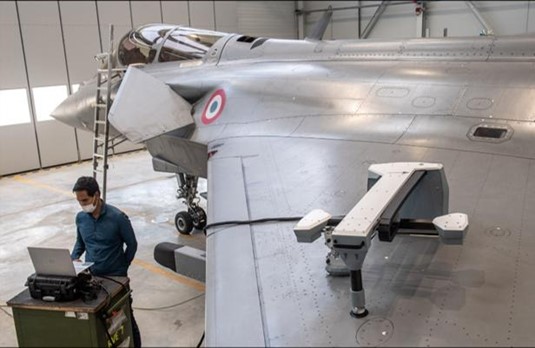Development of an automated system for the inspection of fighter aircraft wings
As part of a national call for projects on aeronautical maintenance, our team was asked to design an innovative solution to automate the periodic inspections carried out on fighter aircraft wings.
These inspections—critical for flight safety—aim to detect the early onset of cracks in specific structural zones subjected to high mechanical stress. These zones are precisely located, and today inspections are performed manually by highly specialized operators using methods that are robust but still largely artisanal.
The inspections involve several steps:
Manual marking of the areas on the part
Calibration, positioning, and acquisition using Phased Array ultrasonic sensors
Manual interpretation of the data collected
These operations are lengthy, physically demanding (constrained postures under the aircraft), and rely on a limited pool of experts who are in high demand.
Our automated inspection solution addresses these challenges by combining safety, accuracy, and traceability.

Objective
Develop an automated, portable, and reliable solution that will :
– Reduce operator strain
– Automate ultrasonic data acquisition on precise areas
– Increase the reproducibility and traceability of inspections
– Reduce the time required for data analysis and interpretation
– Achieve TRL6 (as initially planned) within a short timeframe
Developed Solution
We designed a portable, intelligent, autonomous device that the operator manually positions on each target area. Once in place, the equipment fully handles :
– Automatic localization of the zone
– Precise movement of the Phased Array probe
– Acquisition in accordance with standardized procedures
– Data recording
– Application of preconfigured calibration parameters
An intuitive human–machine interface allows the operator to start acquisition with a single action. The interface also includes :
– Amplitude and time-of-flight maps
– Interpretation aids with automatic sizing of nonconformities
– Structured data post-processing to accelerate analysis
Methodological Approach
The project was conducted using an agile approach inspired by software development: short cycles with frequent prototype deliveries, regular testing in real-world conditions, and continuous co-design with field operators to incorporate their usage constraints from the outset. This iterative approach enabled us to exceed the initial target (TRL6), reach TRL7, and cover 80% of the targeted areas in under one year.
Results
Field results are clear: up to 60% reduction in inspection time on certain areas, a significant decrease in the physical strain of inspections, and a shorter interpretation time thanks to a user-oriented interface. The solution enjoys strong operator acceptance, with personnel now focused on analysis rather than manipulation, and it ensures complete reproducibility and traceability of inspections.
Feedback & Outlook
This project marked our first immersion in the fields of composites and ultrasonic Non-Destructive Testing (NDT). In one year, we :
– Gained a detailed understanding of the sector’s technical and human constraints
– Learned to master the probes, defect characterization, and the operational environment
– Developed a solution that goes beyond a simple prototype
Although 20% of the areas have not yet been covered, we now have :
– A clear view of the missing technological building blocks
– A plan to extend coverage to 100% of surfaces
– Improvement paths, notably in post-processing and automated data analysis
